Back to blog

Blog
01/31/2023
The History of the D'Angelico Headstock

When one thinks of a D’Angelico, the first thing that comes to mind is likely the headstock. It’s the crown of any D’Angelico guitar—a slightly larger profile with a totally unique shape, topped off with an opulent Art Deco emblem and often a decorative ‘cupola’ headpin. Looking at a D’Angelico headstock takes you right back to old New York—long before the era of computers, smartphones and social media. The origins of the acclaimed D’Angelico headstock begin in a small shop in Little Italy, in 1932.
The 1930s was the era of the archtop. Before the days of amplification, guitars needed to cut through the mix of a full band or orchestra acoustically. In these days, the guitar acted more as a percussive instrument, establishing the rhythm of the beat alongside the upright bass and drums.
In 1923, the Gibson L5 was designed and became the staple for this sound. The L5’s arched top, and violin-like F-hole design helped give it a crisp and focused midrange. Competitors like Epiphone and Gretsch joined in, and it wasn’t long before a young John D’Angelico would have his own take on the archtop design, which would go on to set the standard for archtop guitars for decades to come.
Between 1932 and 1964, John D’Angelico built 1,164 instruments. Each instrument was handmade and completely custom to who ordered it. They varied in shape, wood materials, neck profile, finish, and any other detail you can imagine. Headstock shapes and designs also varied from model to model. In this article, we’ll look at the evolution of the D’Angelico headstock and analyze five different designs chronologically from different eras of John’s work.
“The First D’Angelico”
This headstock comes from the first D’Angelico guitar, which was built in 1932. This guitar changed history, paving the way for John D’Angelico’s over 30-year career to follow. Upon completion of this instrument, John D’Angelico would have only been around 27 years old. Prior to this, John apprenticed under his great-uncle Raphael Ciani who made mostly violins and mandolins. After Ciani died, D’Angelico took over the management of the business, but he didn’t like having to supervise the 15 employees, so he ended up leaving the business with his eyes set on building guitars.
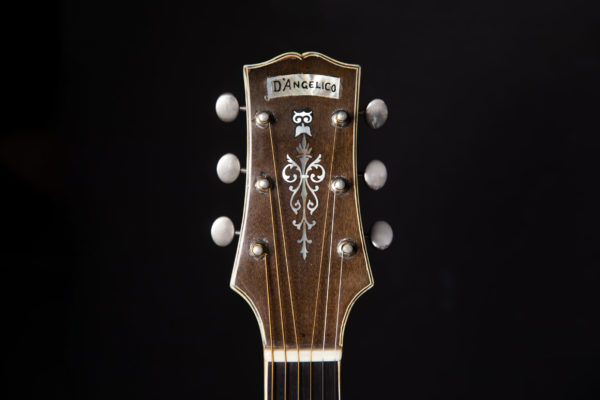
You’ll notice that the headstock of the first D’Angelico is far different from the flagship D’Angelico headstock that evolved years later. It resembles that of a 1930s L5. It features vintage-style grover tuners—which predate the Stairstep tuners featured on most D’Angelico guitars. One of the most special elements of this headstock is the D’Angelico logo itself. It’s hand chiseled on top of a simple mother-of-pearl banner-shaped block. Imperfect, but perfect.

The “first” D’Angelico was recently restored by Chris Mirabella of @mirabellaguitars and currently resides at the D’Angelico Showroom in New York City.
“The Exel”

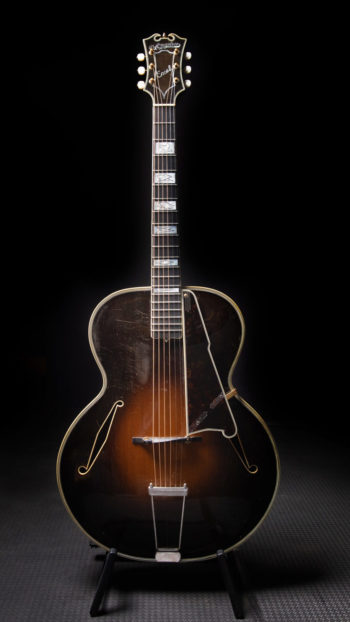
Next, we have a D’Angelico built in 1934. Only a few years after building his first guitar, one can see how John developed his own headstock style and deviated away from the L5. Many elements of a typical D’Angelico headstock are present, such as the unique curvature with sharper and more defined points. It features the mother-of-pearl “D’Angelico New York” logo that’s still being used today.
The most unique part of this headstock is the “Exel” spelling which predates the more classic “Excel” spelling that was incorporated fully by 1936. Was it a misspelling or a deliberate choice? All interpretations are welcome. This term would go on to be the namesake for our Excel Series, which to this day hosts the majority of our traditionally-informed hollow-bodies and semi-hollows, including our flagship archtop designs.
“The A-1 Headstock”
One of the most forgotten headstocks D’Angelico designed is the A-1 headstock. While still an earlier period D’Angelico headstock, it’s more minimalistic in nature and more resembles a Gretsch headstock. Variations of this headstock shape were featured on the D’Angelico Style A model, which was the entry-level D’Angelico first introduced in the mid 1930s. It still featured a solid spruce top with solid curly maple back and sides, but had more understated appointments and hardware. And it had a boutique price tag of $150 dollars.
The A-1 headstock is most famous for being featured on Mary Kaye’s first D’Angelico. In the words of Mary Kaye in a 2003 Vintage Guitar Magazine Interview:
“The first D’Angelico I played was owned by my ex-husband, and was built in the early ’40s. His mother bought it for him from Mel Bay, in St. Louis. It was white, and can be seen on the Trio’s Live On The Sunset Strip album cover… No other guitars in the world could compare to those.”


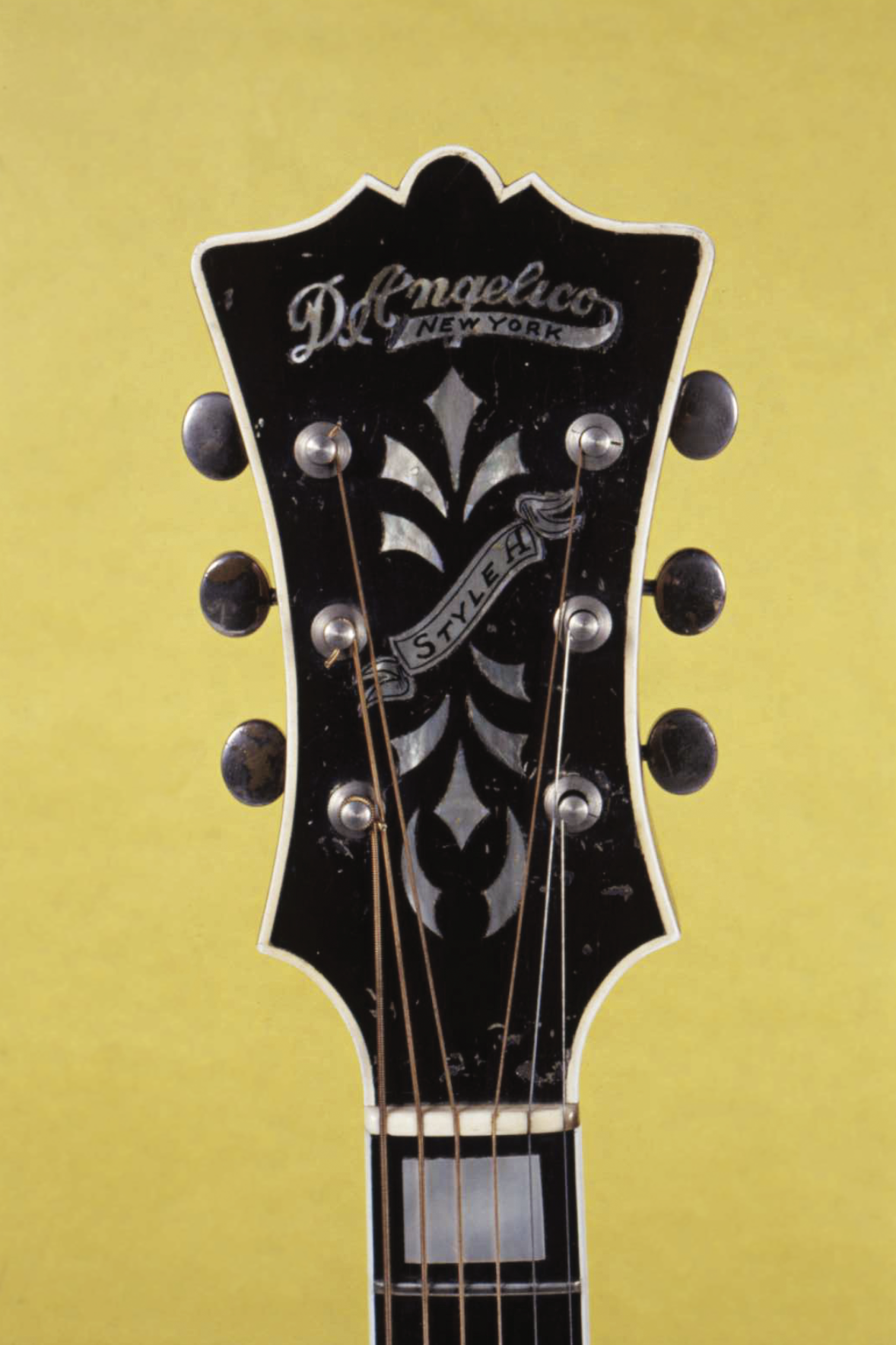
“The Classic Headstock”
By the mid 1940s, we begin to see the headstock evolve more into the classic design we associate with D’Angelico today. It features Stairstep Grover tuners and the classic “Excel” shield emblem that sits on top of a pearwood plate. The edges and points are slightly more rounded than predecessors. It strikes the ideal balance between Art Deco richness and minimalism.
You’ll notice some of the headstocks included an aluminum skyscraper truss rod cover while others did not. This is because John D’Angelico only began incorporating truss rods into his design in the early 1950s. Prior to the inclusion of truss rods, D’Angelico built his instruments with non-adjustable metal ‘T-rods’ that kept
the neck in place.

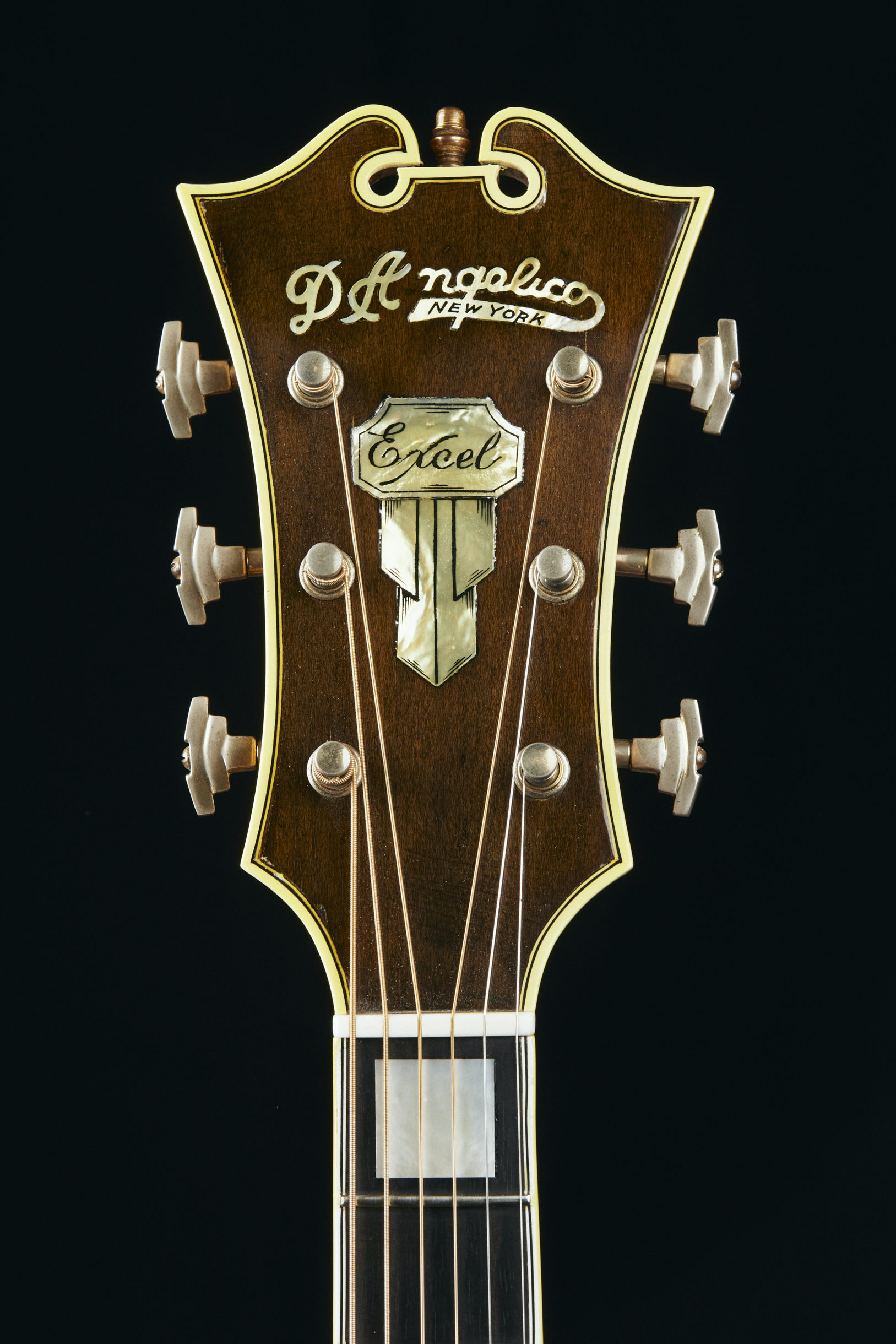
D’Angelico continued to utilize this headstock design, and slight variations on it, throughout the rest of his career, and his apprentice Jimmy D’Aquisto would carry on this legacy by adapting his own version of this headstock shape on his guitars.
“The New Yorker Headstock”
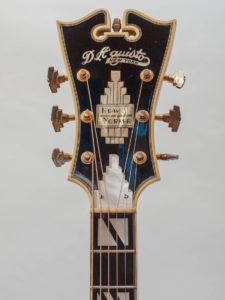

The crown jewel. Variations of this headstock were used throughout John’s career, but it was most famously used on New Yorker models. An old D’Angelico catalog states:
During years of making guitars for artists and leading guitar players, D’Angelico perfected a guitar which has all the features desired and an unmatched tone quality and volume. This guitar — the modern instrument of modern masters — is known as the D’Angelico New Yorker.
New Yorkers were generally 18-inches wide, and needed a larger and bolder headstock to complement the design. The New Yorker headstock often had a 7-ply binding and a more decorative “New Yorker” shield emblem.
By the late 1950s and early 1960s, the combined work of John D’Angelico and Jimmy D’Aquisto resulted in some of the most beautiful and well-respected guitars ever made. Many great luthiers refer to this period as the “Golden Era” of D’Angelico. These dazzling instruments were often topped with variations on the New Yorker style headstock.

Today’s Headstocks
Many different headstock styles, all of which are based on the aforementioned historical designs, are incorporated into present-day D’Angelico models. Our flagship archtop, the Excel EXL-1, utilizes a 1950s style ‘classic headstock’ with the same Excel shield emblem, Cupola head pin and Skyscraper truss rod cover. On the majority of our semi-hollows and solid-bodies, this same headstock has been resized to best complement the body shape and create the ideal weight distribution with minimal neck dive.

In 2020, we introduced the Throwback Collection—the first collection of archtops to feature a variation on the New Yorker Style headstock, which we named the “Throwback Scroll-Style Headstock”. Apart from the 7-ply binding and mother-of-pearl New Yorker shield emblem, one of the most special elements of this headstock was the ebony macassar headplate that brings out the elegance of the design and pays homage to the natural wood headplates that John D’Angelico used.
After receiving such positive response on the Throwback headstock, we’ve since incorporated variations on this design across many different new products—including our new Excel Series acoustic models, the Excel SS and DC XT models, and the brand new Excel Series Tour Collection.
Headstocks continue to shape our instruments today. They remain the crown jewel of any D’Angelico. Even for us, there is still nothing like opening a case for the first time and seeing a new guitar topped off with any one of the iconic and unmistakable D’Angelico headstocks.
